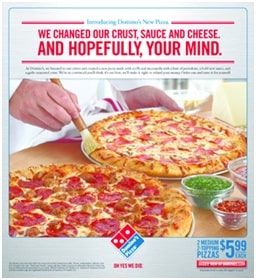As marketers, we labor to elevate brands as high as possible, at the very least above consumer indecision. We create “versus” articles comparing our product to other options on the market. We make disparaging remarks, if not about other companies, about their tactics, results, or methods.
This many not be the best way to go about marketing, however, according to the latest trends and research.
In fact, presenting your company as flawed, transparent, and even off-putting to potential consumers could be a powerful boost for your brand.
This all may seem counterintuitive, but it’s already been tested with phenomenal success by major companies and lauded marketers. Let’s take a look at how transparency in marketing can improve your brand.
Be flawed
All companies would like to appear as authentic. Yet to be truly authentic and human, you have to be able to admit your flaws.
Interestingly, instead of turning away consumers, this level of honesty tends to earn people’s respect. At least that’s what consumer psychologist Adam Ferrier, who is also global chief strategy officer at ad agency Cummins & Partners, believes.
At a recent Mumbrella360 conference in Sydney, he stated that brands may essentially be more desirable if their marketing contains “flaws and blemishes.”
“The era of consumers believing in idealized brands is over.” –Adam Ferrier
He cited, as an example, the “pizza turnaround” case of Domino’s Pizza. During a period of market decline several years ago, the company broadcast all of its criticism to the general public, things like its crust tasting like cardboard, and its sauce being no better than ketchup.

Also very publicly, often in video or other content, the company addressed a majority of customer complaints through recipe modifications. The company even delivered free (and improved) pizzas to some of its most vocal critics.
Because Domino’s Pizza admitted a growing negative perception of its products, the public was more receptive to the fixes. The result was a spectacular turnaround that the eatery enjoys even to this day.
This attitude can also be exemplified in Avis’s classic tag line, “We Try Harder,” a response to criticism in the 1960s that the company was stranded as the second largest rental car provider.
Admitting this shortcoming—and communicating that it thus took nothing for granted—resounded positively with consumers. Avis never became number one with this marketing campaign, but it did become profitable for a change.
Interestingly, admitting to being flawed for a better image is not uncommon in psychology, according to Ferrier. He mentioned a psychosocial theory known as the Pratfall Effect—the notion that the attractiveness of an individual will increase if they commit a blunder, as long as he or she is perceived to be competent beforehand. The theory explains how established celebrities or politicians can actually reinvent themselves to even more success after public scandals.
In essence, take a good look at your company’s shortcomings, whether or not your consumers know about them. Then “mea culpa” them and work to correct them as visibly as possible. If that doesn’t work, then it’s possible your brand was never viewed as competent. If that’s the case, you may need to focus on credibility rather than showcasing your humanity.
As marketing expert Doug Kessler wrote:
“Insane honesty is an under-used tactic that’s amazingly powerful. It says: Take your worst points – and put them in the spotlight. Showcase them for all to see. Lead with them.” –Doug Kessler
Being completely transparent is obviously not easy to do, but why should pioneering marketing ever be an easy task?
Be transparent
Ferrier is far from the only market research authority who contends that the era of idealized brands is over. Even more, others claim that complete transparency is what instills deeper connection between consumer and brand.
In his best-selling book Youtility, Jay Baer calls this view “radical transparency.” He defines it as “providing answers to nearly every question a customer could conceivably ask—before they think to ask it.”
In our professions, we may worry about future questions to a product or situation. Baer suggests publicly addressing these and every other question publicly before anyone brings them up. It would be like Domino’s Pizza admitting its flawed product long before its profits dipped.
A true example of this is Amazon, who feels that they’ve failed as a company if customer service is contacted. Their contention is that customers should have all answers and solutions available on its Web pages.
Baer suggests that businesses should “let it all hang out,” even negative aspects (he refers to this as “the metaphorical sausage being made”). His illustration is Holiday World, an amusement park that details openly every ride, every risk, and every piece of science involved in its operations. This attitude of unambiguousness has made the amusement park a top attraction in the nation.
Baer further states that “no question is unworthy of an answer, and that filling information gaps is of equal importance to promotion and chest-thumping.”
As Baer further says in Youtility:
- Companies with websites with 101 to 200 pages generate two-and-a-half times more leads than companies with 50 or fewer pages.
- Companies that blog fifteen or more times per month get five times more traffic than those that don’t blog.
In other words, companies that are open to revealing how they make their “metaphorical sausage” online are typically rewarded with that sought-after traffic.
Be off-putting
No, I’m not suggesting that you tap into your inner Soup Nazi. It’s is more of a reminder that self-knowledge is just as important as knowledge of consumers or clients. You need to not only understand, but admit, your company’s limitations.
This is exemplified by a quote from Steve Jobs:
“Deciding what not to do is as important as deciding what to do.” –Steve Jobs
In effect—know who you are, what you can do, and who you serve.
It’s natural to want to be everything to everyone in that search for traffic or sales. But in the Age of Information, consumers are as smart and suspicious about brands as never before—so this approach could spread marketing campaigns so thin, they fail.
Being off-putting certainly echoes the words of another best-selling marketer, Ann Handley, who said:
“We should be developing content that actively repels people we don’t want to work with.” –Ann Handley
Or as Joe Pulizzi, founder of Content Institute Marketing, explained in a recent newsletter:
“If you are trying to create content that everyone likes, it won’t be compelling enough. Satisfying everyone means having no point of view. It means boring content.” –Joe Pulizzi
This attitude certainly applies as well to all other forms of marketing, and basically everything else involving consumers.
Know who you are and what you are not. The threat of being boring should be enough warning to any serious content marketer.
Conclusion
All of this points to one simple notion: Customers and clients are human, and increasingly desire brands that are just as human (or at least can visibly see the humans behind the brands).
The age of brand worship is over, and the age of authenticity has arrived. People actually like transparency in marketing. Which means the three approaches we covered here are not as counter-intuitive as they may seem—and may actually be very good news for marketers because they open so many new channels of engagement.
In the end, they make content and communication so much more human.
How do you feel about absolute transparency or rejecting people who aren’t your best prospects? I’d love to hear your perspective.
About the Author: Miguel Conner is the Marketing Director at qSample, a research and data collection firm in Chicago specializing in hard-to-find B2B and B2C panels. He also consults for several companies including Free Green Concepts, J. Edward Lending and Phoenix Marketing. He has published dozens of articles and several books including Voices of Gnosticism, Stargazer and The Executioner’s Daughter. Connect with him on LinkedIn.


